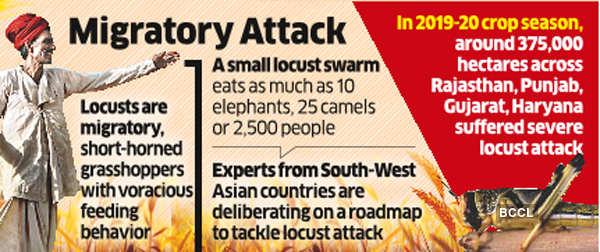
NEW DELHI: Locust swarms from Pakistan have entered Rajasthan, Punjab, Haryana and Madhya Pradesh threatening major damage to standing cotton crops and vegetables over more than 200,000 hectare. These states have sought immediate help from the Centre.
Rajasthan, which is the most affected with 16 out of 33 districts battling intense locust attack, has asked the Centre to provide more spray vehicles, drones and helicopters for spraying pesticides. In Madhya Pradesh, 15 districts are likely to be affected while districts bordering Rajasthan have been put on high alert in Haryana and Punjab.

Rajasthan chief minister Ashok Gehlot has written to PM Narendra Modi seeking immediate help.
“Food and Agriculture Organization of the United Nations has warned of a large-scale locust outbreak this year and the impact will be 2-3 times higher than that of the previous year. We have floated tender for drones, which can spray pesticides to areas which are inaccessible by vehicles,” said Rajasthan agriculture minister Lal Chand Kataria.
The central government is coordinating with states to control locust attack before the kharif sowing begins in June.
“Currently, cotton is planted in major areas. Once the kharif sowing takes off, the risk will intensify. We have so far controlled attack of locust across 14,299 hectare at 150 places in districts of Punjab and Rajasthan. Now the latest attack has given us more to worry,” said a senior agriculture department official.
He said the locust army has swarmed Indian territory earlier than scheduled. The Locust Control Organisation has deployed 50 spray vehicles to get rid off locust army and restrict their spread. “Generally, locust army enter desert of India from Pakistan during June and July. But this time, they were first located on April 11 in Rajasthan,” he said.
The government regularly coordinates with South-West Asian countries like Afghanistan, Iran and Pakistan where locust attacks are a common phenomenon.
Source: indiatimes.com

